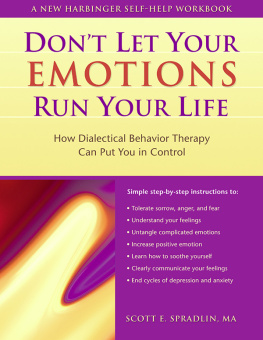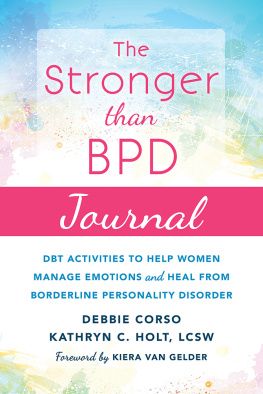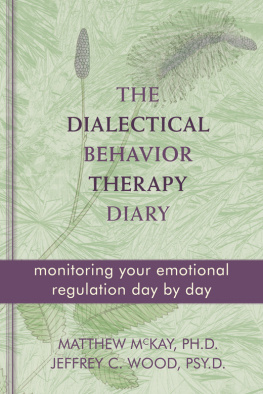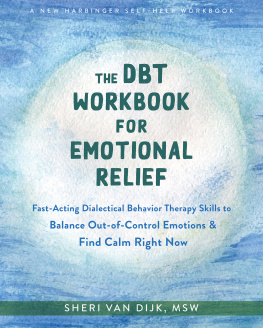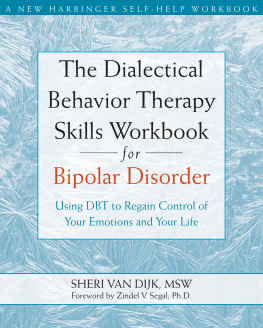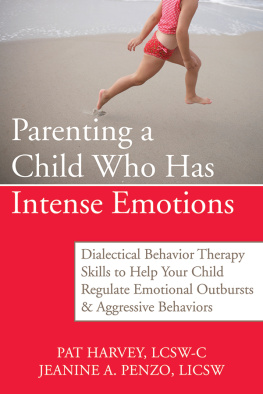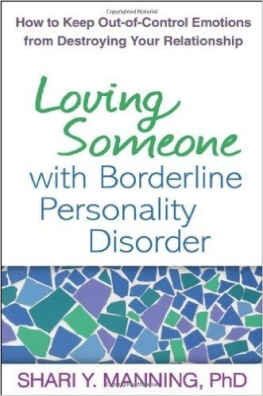
Dont Let Your Emotions Ruin Your Life
Scott E. Spradlin
New Harbinger Publications
Publishers Note
This publication is designed to provide accurate and authoritative information in regard to the subject matter covered. It is sold with the understanding that the publisher is not engaged in rendering psychological, financial, legal, or other professional services. If expert assistance or counseling is needed, the services of a competent professional should be sought.
Distributed in Canada by Raincoast Books.
Copyright 2003 by Scott E. Spradlin
New Harbinger Publications, Inc.
5674 Shattuck Avenue
Oakland, CA 94609
Cover design 2002 by Lightbourne Images
Edited by William Rodarmor
Text design by Tracy Marie Carlson
ISBN; 1-57224-309-0 Paperback
ISBN: 978-1-60882-421-2 Epub
All Rights Reserved
New Harbinger Publications Web site address: www.newharbinger.com
To all of my DBT clients past and present who have been so gracious as to let me participate in their struggles for life and their journeys toward healing.
Contents
A number of people have had a hand in this book coming to besome directly, others indirectly. I appreciate and thank Patrick Fanning and Matthew McKay of New Harbinger Press for inviting me to do this project. Also at New Harbinger I must thank Tesilya Hanauer and Heather Mitchener for editorial motivation, and walking with me through this process. They made this experience enjoyable and worthwhile. To William Rodarmor, I truly appreciate his wit, focus, and skill. He did a tremendous job of streamlining mangled sentences and paragraphs and saved the public from inane academic jargon and charts.
It was Brad Hubert and Greg Mulkey, then of Luke-Dorf, Inc., who first sent me to train in dialectical behavior therapy (DBT). This led me to Soonie Kim, Ph.D., who provided an excellent introduction to DBT principles and practices, and who brought me into the DBT fold, as it were, by inviting me to become a member of the Portland DBT Program. The team at Portland DBT demonstrated phenomenological empathy, compassion, and fallibility. Particularly Alice Rose, LCSW, who mentored me in leading skills-training groups (to this day I mimic you when I lead groups). It was a great honor to work with true experts.
Immeasurable gratitude goes to Marsha Linehan, Linda Dimeff, and Kelly Koerner of Behavioral Technology Transfer Groupthe DBT trinity, in my mind. The Seattle intensive was like boot camp for DBT therapists. This training increased my theoretical knowledge of borderline personality disorder (BPD) and DBT, but most importantly, their personal commitment to the clients we treat renewed my compassion, confidence, and sense of mission in treating borderline individuals. Many of these clients not only survive because of DBT but are also thriving beyond their own expectations. If not for Marshas team and research, many of us would still be at a loss for how help our borderline clients. I hope this workbook does justice to DBT, and will be a usable tool for clients and practitioners.
It was at the Portland Providence Medical Centers Crisis Triage Center (CTC), that my limits and creativity were stretched during my stint as Captain Midnight, adapting DBT to crisis calls on the graveyard shift. My time there has influenced my practice, especially with respect to teaching clients skills for collaborating with crisis service providers. The clinical and medical staff showed hope in the face of despair and helped me to see our work as a healing art. While at the CTC, Im grateful to have become friends with Jane Erickson, Deb Roth, and Ellen Barker (aka Encarta) and for their encouragement on the workbook as well as their general concern for Captain Midnight. Likewise for Marianne Irish for creative friendship and her love of poetry, and Elyce Benham, who was the Sculley to my Mulder and with whom I shared the overnights.
I simply must thank all of the caf owners and baristas who tolerated me loitering with my laptop during this process. In Portland, Oregon, I thank the Starbucks crew at 45th & Glisan where I could write on break from my shifts at Providence Hospital. I especially thank John Asparro and Valerie Dianna of True Brew Caf in Southeast Portland for the most affordable and delicious lattes ever. In Wichita, Kansas, I thank Amy Clarke, an Oregon transplant and proprietor of the Bean Scene, and the kind people at Watermark Books & Cafe.
My good friend Rebecca Campbell, doctoral candidate in neuroendocrinology at Oregon Health Science University provided several informal consultations about brain functions, and the napkin diagram of the hypothalamus. Blessings to you and Andrew as you move to New Zealand. T. J. Civis is a creative friend and filmmaker who also encouraged me by working on his own projects and through our short-lived writers group.
Finally, I thank my psychologist wife, Jill, for her encouragement to complete this project and all the free therapy. It was her attendance at George Fox University that led us to Portland and resulted in my involvement in DBT, and so, in a manner of thinking, this project is perhaps ultimately thanks to her.
The principles and techniques presented in this workbook derive from my training and experience as a practitioner of dialectical behavior therapy (DBT), which was developed by Marsha Linehan and her colleagues at the University of Washington. DBT has garnered accolades from professionals and recipients of therapy for its effectiveness in treating borderline personality disorder (BPD).
People affected by BPD suffer quick, intense emotional spikes, which send them reeling into emotional dysregulation. It can take borderlines a long time to recover from these spikes and return to their normal mood or emotional baseline. The experience has been described as heating up like a microwave oven but cooling down like a conventional one. Its as though the emotions take over, and once they do, it takes a while before the people are back in control. And while these people are cooling off, theyre even more vulnerable to the next trigger.
People diagnosed with BPD are emotionally sensitive, and find themselves being overly emotional, but they arent the only ones who have trouble regulating their emotionswe all do. There have probably been times in each of our lives when we can remember not being in our right mind, and weve all heard of crimes of passion committed in the heat of a moment.
Theres a wide spectrum of emotional sensitivity, and it varies from one person to another. Some people oscillate between over-control and over-expression. Others stuff or hide their emotions for months before they finally blow their stack and stand up for themselves through overly aggressive behaviors. All of this is to say that you dont need to be formally diagnosed with an emotional disorder to benefit from this book. You may be a person who has been formally diagnosed and be in treatment, but thats not a requirement. The book can help you to better understand your emotions, and to see that they play an important role in your lifeaside from torturing you. It may also help reduce your vulnerability to being overly emotional, and decrease self-defeating beliefs, thoughts, and judgments about yourself.
You might say this is a book for increasing your emotional intelligence. It addresses factors such as physiology, the nature of emotion, diet, relationships, skills for cooling down, and ways to understand how to experience your emotions with less self-judgment.
As we get underway, I want to acknowledge that as a DBT practitioner, much of the material here is based on the ideas of Marsha Linehan and her colleagues at the University of Washington, and Linehans published material in her
Next page
